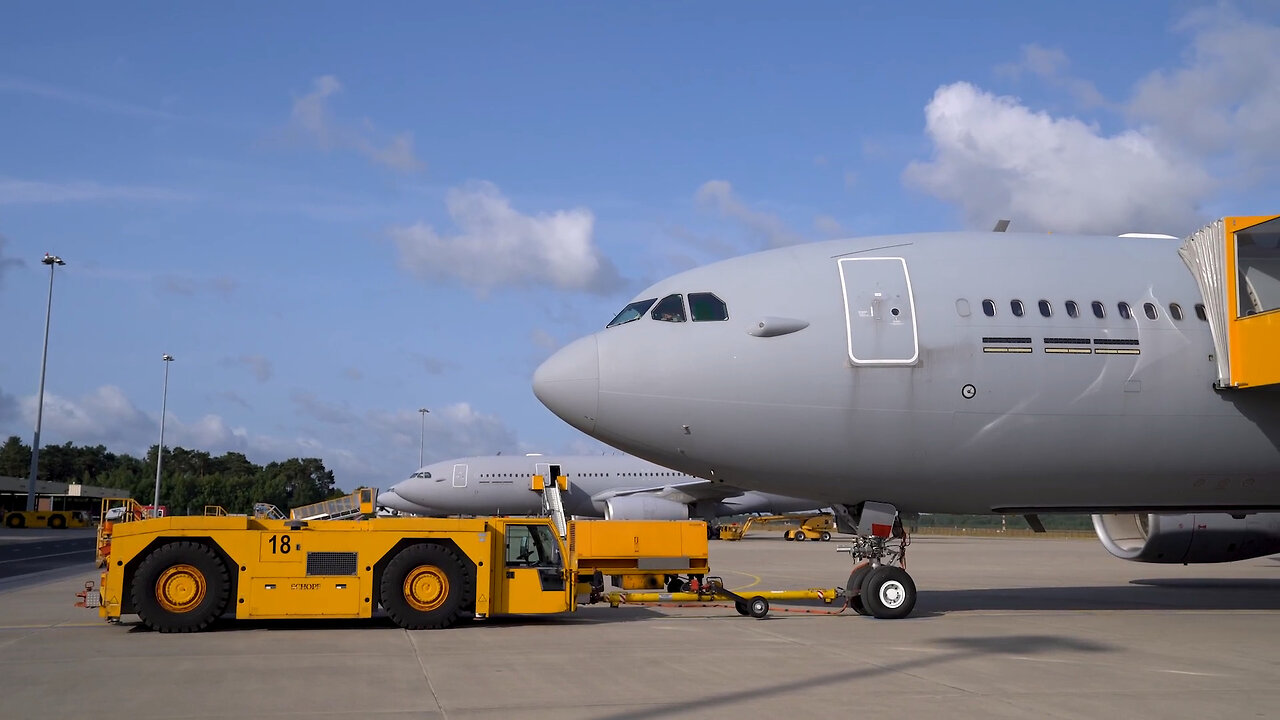Premium Only Content

NATO Allied fighter jets stand ready to secure Allied skies
Credit: Courtesy | Date Taken: 04/07/2023
Watch NATO Allied fighter jets scramble for the skies in an exercise to respond to airborne threats. Synopsis Every day, NATO Allies’ fighter jets are on alert to secure Allied skies against external aggression or unpredictable behaviour. NATO Air Policing mission is on duty 24 hours a day, 7 days a week, 365 days a year. If unidentified air traffic passes through or near NATO airspace, fighters assigned to this mission can scramble to intercept and verify its identity. This is a standing peacetime task that has been carried out for decades. At NATO Air Policing mission in the Baltics, for example, Allies regularly scramble to intercept Russian military traffic transiting the Baltic Sea. When these jets don’t respond to hails from air traffic controllers, NATO’s Combined Air Operations Centres order jets to scramble from Estonia and Lithuania to verify their identity. Currently, Portugal and Romania are covering this mission with F-16 Fighting Falcons flying from Šiauliai Airbase in Lithuania. Since Russia’s illegal invasion of Ukraine in February 2022, Allies have stepped up patrols in the eastern part of the Alliance to ensure that NATO can defend its skies on short notice. Some of these patrols are supported by aerial refuelers like the A-330 Multinational Multi-Role Tanker Transport, an asset collectively owned by a handful of NATO Allies. Footage includes Allied fighter jets from Finland, Germany, the Netherlands, Poland, Portugal, Romania and the United Kingdom, and fighter jets from NATO invitee Sweden conducting airborne operations. With soundbites from the commander of the Combined Air Operations Centre (CAOC) Uedem, and from the commanders of the Portuguese and Romanian F-16 detachment in Lithuania. Transcript ---SHOTLIST— (00:00) VARIOUS SHOTS - A330 MULTIROLE TANKER TRANSPORT AIRCRAFT AT EINDHOVEN AIRBASE (00:06) VARIOUS SHOTS – DUTCH AIR FORCE PILOTS INSIDE THE COCKPIT OF A A330 MULTIROLE TANKER TRANSPORT AIRCRAFT PREPARE TO TAKE OFF. (00:24) VARIOUS SHOTS – DUTCH AIR FORCE PILOTS INSIDE THE COCKPIT OF A A330 MULTIROLE TANKER TRANSPORT AIRCRAFT IN PREPARATION OF A FORMATION EXERCISE WITH DUTCH FIGHTER JETS. (00:47) VARIOUS SHOTS – DUTCH AIR FORCE F-16s (01:04) VARIOUS SHOTS – GERMAN AIR FORCE EUROFIGHTER TYPHOONS (01:41) VARIOUS SHOTS – DUTCH PILOTS INSIDE THE COCKPIT OF A A330 MULTIROLE TANKER TRANSPORT AIRCRAFT IN PREPARATION OF A FORMATION EXERCISE WITH POLISH FIGHTER JETS. (01:53) VARIOUS SHOTS – POLISH AIR FORCE F-16s (02:12) VARIOUS SHOTS – PORTUGUESE AIR FORCE F-16s (02:35) VARIOUS SHOTS – LINE UP OF FINLAND, PORTUGUESE, ROMANIAN FIGHTER JETS DEPLOYED IN ŠIAULIAI AIR BASE, LITHUANIA. (02:40) VARIOUS SHOTS – LINE UP OF FINNISH F/A-18s IN ŠIAULIAI AIR BASE, LITHUANIA. (02:50) MEDIUM SHOT – ROMANIAN AIR FORCE F-16s IN ŠIAULIAI AIR BASE, LITHUANIA. (02:54) MEDIUM SHOT – LAUNCH SCRAMBLE ALERT GOES OFF IN ŠIAULIAI AIR BASE, LITHUANIA. (03:00) MEDIUM SHOT – ROMANIAN AIR FORCE F-16 CREW SCRAMBLES (03:54) MEDIUM SHOT – ROMANIAN AIR FORCE F-16 TAKES OFF (04:01) VARIOUS SHOTS – UK ROYAL AIR FORCE EUROFIGHTER TYPHOONS (04:09) VARIOUS SHOTS – ROMANIAN AIR FORCE F-16 (04:22) VARIOUS SHOTS – FINNISH AIR FORCE F/A-18s (04:37) VARIOUS SHOTS – FINNISH AIR FORCE F-18 IN PRE-CONTACT REFUELLING POSITION WITH THE MULTIROLE TANKER TRANSPORT AIRCRAFT HOSE AND DROGUE UNIT (04:43) VARIOUS SHOTS – FINNISH AIR FORCE F-18 IN REFUELLING POSITION WITH THE MULTIROLE TANKER TRANSPORT AIRCRAFT HOSE AND DROGUE UNIT (04:53) VARIOUS SHOTS – SWEDISH AIR FORCE JAS 39 GRIPEN FIGHTER AIRCRAFT (05:07) COLONEL COSMIN VLAD, COMMANDER OF THE ROMANIAN F-16 DETACHMENT IN LITHUANIA “During the last years, the Romanian commitment to NATO was increasing a lot. And part of this is our contribution to Baltic air policing mission. It is the second time we are here. First time it was back in 2007 with MiG-21s and now with F-16s.” (05:27) COLONEL COSMIN VLAD, COMMANDER OF THE ROMANIAN F-16 DETACHMENT IN LITHUANIA “It's really important for Romania to be here to demonstrate our commitment, our increased commitment to NATO and the contribution of Romania to safeguarding the NATO airspace. We are really happy to work here together with our Portuguese partners and our Finnish partners, especially given the context of NATO's summit, which is going to be held in just one week here in Lithuania.” (06:00) CALLSIGN “VIRIATO”, COMMANDER OF THE PORTUGUESE F-16 DETACHMENT IN LITHUANIA “We are here doing a contribution for the policing of the Baltic countries' airspace. So we are here since the 1st of April and we’ll stay here till the end of July and we have four jets ready to scramble as you witnessed and to perform any mission required here in the Baltics.” (06:24) CALLSIGN “VIRIATO”, COMMANDER OF THE PORTUGUESE F-16 DETACHMENT IN LITHUANIA “Well, it's important, first of all, because we can contribute with what we know to do best, which is this type of mission, the QRA, the quick reaction alert. At the same time, it's a great opportunity to train with different partners from different nations that are in the Baltic region and not only the air forces, but as well, some ground troops. So it's the best opportunity that we have to practise together as a united force.” (07:00) MAJOR GENERAL HAROLD VAN PEE, COMMANDER OF NATO’S COMBINED AIR OPERATIONS CENTRE UEDEM “So we often get the question why does NATO have to coordinate all this air policing activities, because in most countries in Europe, they do have their own air force and they do have the capabilities to intercept unauthorised aircraft on their own. But as you know, most countries in Europe are rather small. So if you would have a traffic flying to European airspace, quite often, it would only take like 10 minutes before it reaches the next country. But in general, it will never take more than 30 to 45 minutes. So it would not be wise. It would be optimal for this way to have the nations do that all separately over their territory. So just for a little something we try to coordinate the air policing efforts to make it more efficient and more effective. Because under NATO control, NATO fighters are allowed to cross into the neighbouring country so that we can actually continue to intercept throughout several NATO countries.” (08:01) MAJOR GENERAL HAROLD VAN PEE, COMMANDER OF NATO’S COMBINED AIR OPERATIONS CENTRE UEDEM “The air policing mission over the Baltic Sea region is essentially still what it was years ago because it is a peacetime air policing mission, and that mission as such has not changed over time. But the Baltic Sea region is special, for two reasons. First of all, because that's where we tend to see most of the Russian interactions, so interactions with the Russians, because the Russians have to basically fly from their enclave, Kaliningrad, back to the Russian mainland along the coast of the three Baltic states. So of course, obviously, that’s where we then get to intercept them. So that's where we see most of our day to day interaction with Russian assets. But the second reason is that the three Baltic states, although they have their own air force, they lack fighter jets, so they don't have the means to actually intercept unauthorised aircraft. And that's where NATO steps in. So we provide that framework for them by inviting other nations to deploy forces on a temporary basis to one of the Baltic states.” (09:01) MAJOR GENERAL HAROLD VAN PEE, COMMANDER OF NATO’S COMBINED AIR OPERATIONS CENTRE UEDEM “Finland is now part of NATO, but they still need to fully integrate into the NATO air policing business. And that's partly technical. It's partly procedural, but I mean, we'll get there. It's just a matter of time, but it's going to go relatively fast. Sweden will be the same case once they’ll actually become a NATO member. (09:21) MAJOR GENERAL HAROLD VAN PEE, COMMANDER OF NATO’S COMBINED AIR OPERATIONS CENTRE UEDEM “For NATO, I mean, Finland, of course, brings a lot of air capabilities to the table. So they have a pretty robust air force with lots of also with early airborne warning aircraft, intelligence collection aircraft is not only limited to fighters, they bring in a lot of intel collection capabilities as well. So, yeah, of course, they know their neighbour, the big neighbour to the east rather well, so I mean, NATO is gaining a lot from that expertise of course.” Usage rights This media asset is free for editorial broadcast, print, online and radio use. It is restricted for use for other purposes.
-
 LIVE
LIVE
Side Scrollers Podcast
53 minutes agoCracker Barrel CANCELS Rebrand + OG YouTuber Has Brain Tumor + More | Side Scrollers IN STUDIO
205 watching -
 LIVE
LIVE
The Mel K Show
38 minutes agoMORNINGS WITH MEL K - Reexamining the US relationship with International Banks, Treaties, and NGOs 8-27-25
482 watching -
 LIVE
LIVE
The Shannon Joy Show
2 hours ago🔥🔥SAVE Baby Kit! Hospital Injects 2 Pound Baby With Hep B Vaccine Without Mom’s Consent, Injures Him Severely Then Calls CPS On The Family!🔥🔥
111 watching -
 LIVE
LIVE
Viss
1 hour ago🔴LIVE - Improve Your Battle Royale Play with Tactics & Strategy! - PUBG
159 watching -
 LIVE
LIVE
Grant Stinchfield
2 hours agoBallot Harvesting Scams EXPOSED: Dead Voters, Fake Signatures, Real Crimes
96 watching -
 1:01:40
1:01:40
VINCE
3 hours agoThe Democrats' Ticking Time Bomb | Episode 112 - 08/27/25
137K93 -
 LIVE
LIVE
JuicyJohns
3 hours ago $0.42 earned🟢#1 REBIRTH PLAYER 10.2+ KD🟢
60 watching -
 LIVE
LIVE
LFA TV
5 hours agoLFA TV ALL DAY STREAM - WEDNESDAY 8/27/25
5,456 watching -
 LIVE
LIVE
GloryJean
2 hours agoAggressive Solo Gameplay on Mouse & Keyboard 🖱️ 6.7 K/D
44 watching -
 LIVE
LIVE
The Pascal Show
1 hour ago $0.11 earnedBREAKING! Mass Shooting At Annunciation Church In Minneapolis Multiple Shot
61 watching